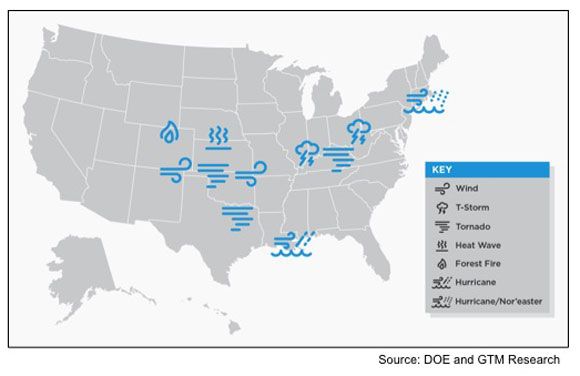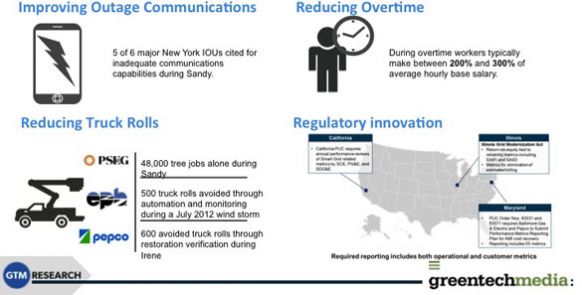When it comes to power outages, the big ones count both more and less than the little ones, according to a new white paper from GTM Research:
Major outages, which affect more than 10% of a utility’s customers, are rarely used in the calculation of reliability indices such as System average Interruption Frequency Index (SAIFI) and System average Interruption Duration Index (SAIDI).
The scale and variety of these major outage events tend to overwhelm legacy outage-management tools, preventing utilities from meeting the expectations of external stakeholders and exposing the lack of accurate simulation capabilities and extensible tools. Heightened regulatory scrutiny, coupled with the increasing frequency and severity of these events, is making management of extreme conditions more important to utilities’ bottom lines.
The outages that only last for only ten minutes or an hour may be the ones that affect SAIFI and SAIDI scores, but it is the Katrinas, Irenes and Sandys of the world that get the attention of legislators and regulators, who then pressure utilities to do more. In 2012, eleven events caused more than $1 billion in damage in the U.S.
Utilities are not simply just increasing tree-trimming sessions or running more drills. New analytical tools and hardware equipped with digital capabilities are allowing utilities to reduce small outages to barely noticeable and hopefully respond far better to the major catastrophes. Companies such as S&C Electric, ABB’s Ventyx and Schneider Electric are all eager to offer solutions for utilities that want to, or need to, invest in next generation outage management that combine the best in IT and OT.
GTM Research identified six primary drivers for utilities to invest in advanced distribution management systems (ADMS), which can combine distribution automation and outage management:
- Increasing information expectations. Regulators and customers want information that is accurate and instant during outages. That includes mobile capabilities and specific times for estimated time of restoration. Some utilities are taking social media feeds into their outage management systems, but innovation in this area is really just starting.
- Reduction in unserved electricity. Simply put, the outages mean no one is paying for electricity, because no one is using it, and utilities are losing revenue. For utilities, this means that investments in reducing outages can directly impact their bottom line -- especially if they can do it using IT solutions rather than relying on expensive alternatives like burying lines.
- Reduced overtime pay. Overtime racks up fast when major outages roll across a utility’s territory. New ADMS that can do digitally what used to have been done manually can greatly reduce operator overtime hours during major outages. Better communications and planning between the field and operators can ensure that field crews are deployed most effectively.
- Reduction in truck rolls and miles driven. Situational awareness is key in outages, not just to pinpoint where the fault is, but also to ensure when full power is restored. Smart metering systems coupled with an ADMS have already shown benefits to some utilities to ensure crews can find faults more quickly and ensure it’s completely fixed before driving to another location.
- Increasing flexibility of performance-based ratemaking. In recent years, regulators and legislators have been turning to performance metrics beyond just SAIFI and SAIDI to keep investor-owned utilities accountable for their investments. California, Illinois and Maryland have all ordered annual performance reviews for major utilities. The latter two states have tied cost recovery to meeting specific metrics.
- Deeper evaluation of performance during major events. Although it’s a given that there will be outages after major weather events, utilities are increasingly being held responsible for prolonged outages. Earlier this year, for example, Commonwealth Edison was ordered to pay customers for damages from a prolonged outage in 2011.
Download the white paper here.





